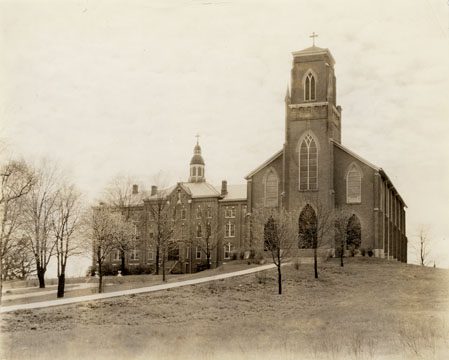Checking Out Historic and Modern Churches for All Confidences
The exploration of historic and contemporary churches acts as a profound lens through which we can take a look at the advancement of confidence and area characteristics throughout societies. From the intricate designs of ancient cathedrals to the minimalist appearances of contemporary worship areas, these structures encapsulate the essence of their time and place. They are not merely churches; they are representations of cumulative aspirations and social worths. As we think about the importance of these sacred websites, one need to contemplate exactly how they proceed to form interfaith dialogue and community interaction in today's varied globe.
Building Styles Via the Ages
As architectural expressions of spirituality, churches have advanced dramatically over the centuries, showing the varied doctrinal and cultural impacts of their times - Logan Ohio Churches. The architectural designs of churches are as varied as the idea systems they represent, each design symbolizing specific spiritual doctrines and area values
Very early Christian design arised from Roman basilicas, defined by simple, longitudinal frameworks featuring a nave and aisles. As the Center Ages progressed, Gothic style took hold, noted by pointed arcs, ribbed vaults, and flying buttresses, which permitted larger tarnished glass windows that lit up insides with magnificent light. The Renaissance duration brought a revival of timeless aspects, highlighting percentage and proportion, while Baroque architecture introduced remarkable kinds and fancy information, symbolizing the magnificence of spirituality.
In the 19th and 20th centuries, the increase of various movements, such as Crafts and arts and Modernism, showed societal changes and a separation from conventional kinds. Today, modern churches usually blend modern-day materials and cutting-edge layouts, accepting sustainability and community involvement. This rich tapestry of architectural designs highlights the continuous discussion in between belief and style, showcasing just how churches continue to adapt to the spiritual needs of varied populaces across the world.
Famous Historic Churches

One more exceptional instance is the Notre-Dame Cathedral in Paris, commemorated for its French Gothic style. Its detailed façade and stunning stained glass windows show centuries of commitment and creativity, making it a sign of both belief and strength, particularly after its current restoration complying with the ravaging fire in 2019.
In the Americas, the historic Goal San Juan Capistrano in California showcases Spanish colonial architecture, highlighting the early Catholic objectives that played a crucial function in the region's cultural growth.

In Addition, the Hagia Sophia in Istanbul, originally built as a sanctuary, stands for a blend of Christian and Islamic heritage, showcasing the abundant tapestry of history that churches commonly embody. Each of these historical churches not only acts as an area of prayer however likewise as a cultural landmark, protecting the stories of varied areas throughout time.
Modern Church Innovations
Modern churches are significantly welcoming ingenious styles and innovations to improve the worship experience and foster community engagement. These innovations show up in numerous types, from architectural developments to digital assimilation. Several modern churches feature open, flexible rooms that can be quickly reconfigured to fit diverse tasks, such as services, celebrations, and educational programs.
Including modern technology is vital in modern church layout. High-grade audio-visual systems, online streaming capabilities, and interactive display screens enable parishes to attach not only within their wall surfaces yet likewise with a broader target market online. This digital outreach has become crucial for preserving community connections, particularly in a period where numerous people seek spiritual links beyond typical settings.
Lasting style techniques likewise play an essential duty in modern church technologies. Numerous establishments are selecting eco-friendly products and renewable energy resources, reflecting a commitment to ecological stewardship that resonates with congregants.
Additionally, the integration of art and imagination right into worship areas, via multimedia, murals, and setups presentations, serves to improve the spiritual atmosphere, making the experience much more immersive. These technologies jointly reflect a change in the direction of a more vibrant and inclusive method to prayer and area This Site life.
Community Effect of Churches
Churches play an important function in shaping and uplifting neighborhoods, commonly tipping up to attend to neighborhood requirements and difficulties. Past their spiritual functions, these organizations often engage in social outreach and offer vital solutions that promote area communication. Many churches run food financial institutions, shelters, and counseling services, resolving problems such as hardship, being homeless, and psychological wellness.
In addition, churches usually function as meeting place for neighborhood occasions, helping with dialogue and unity amongst varied groups. By organizing curricula, workshops, and cultural events, they urge individual growth and cumulative empowerment. Their interaction in regional advocacy initiatives magnifies the voices of marginalized neighborhoods, adding to social justice campaigns.
Furthermore, churches frequently team up with regional organizations, boosting their impact via partnerships that combine sources and knowledge. This interconnectedness strengthens neighborhood ties and advertises a sense of belonging amongst residents.
Fundamentally, churches are not merely areas of worship; they are indispensable to the social material of their areas. Their multifaceted payments-- spiritual assistance, social solutions, and community activism-- play an essential duty in fostering durability and favorable change within culture.
Visiting Churches Around The Globe
When discovering the diverse landscapes of spirituality, checking out churches all over the world provides an one-of-a-kind window into the creative and social expressions of confidence. Each church works as a testament to the background and worths of the community it represents, reflecting local customs and architectural designs.
From the grandeur of St - Logan Web Site Ohio Churches. Peter's Basilica in Vatican City to the minimalist appeal of Tokyo's St. Mary's Sanctuary, these spiritual spaces embody a rich tapestry of human experience. The complex tarnished glass of Chartres Sanctuary in France narrates biblical stories, while the dynamic murals of the Ethiopian Orthodox churches illustrate the country's distinctive spiritual heritage
In enhancement to showcasing imaginative mastery, churches frequently function as facilities of neighborhood and social involvement, organizing occasions that reinforce bonds amongst congregants. Several additionally offer opportunities for interfaith dialogue, promoting understanding and regard amongst various idea systems.
Taking a trip to these churches permits site visitors to value the universal styles of hope, love, and empathy that transcend cultural barriers. Whether one understands a certain confidence or otherwise, the experience of seeing these spiritual sites enhances our understanding of the human quest for meaning and connection.
Conclusion

The expedition of modern-day and historical churches offers as a profound lens with which site web we can examine the evolution of faith and community dynamics throughout societies. Today, modern churches usually mix modern-day products and ingenious styles, accepting sustainability and neighborhood engagement.Throughout history, numerous churches have emerged as iconic spots, each informing an unique tale of creativity, faith, and community.Modern churches are increasingly embracing cutting-edge layouts and innovations to enhance the prayer experience and foster neighborhood engagement.Moreover, churches often offer as event locations for area events, facilitating discussion and unity among varied teams.
 Lark Voorhies Then & Now!
Lark Voorhies Then & Now! Molly Ringwald Then & Now!
Molly Ringwald Then & Now! Tatyana Ali Then & Now!
Tatyana Ali Then & Now! Jenna Jameson Then & Now!
Jenna Jameson Then & Now! Teri Hatcher Then & Now!
Teri Hatcher Then & Now!